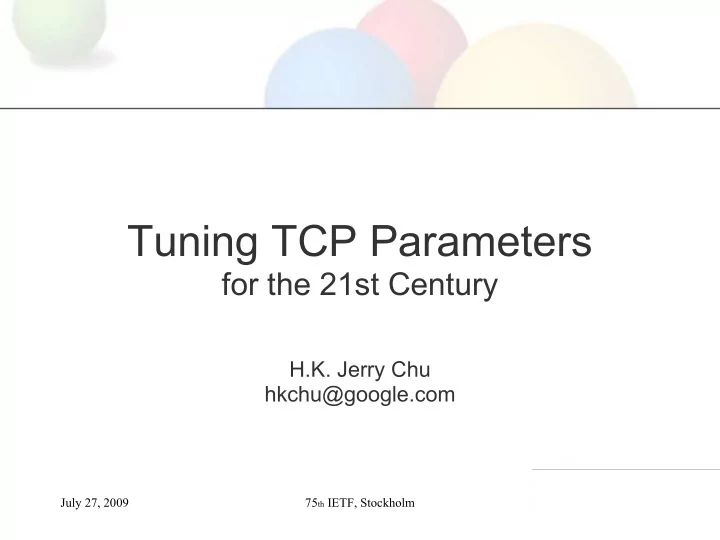

Tuning TCP Parameters for the 21st Century H.K. Jerry Chu hkchu@google.com July 27, 2009 75 th IETF, Stockholm
Parameters to Examine init RTO (for 3WHS and init data transmission) initcwnd (IW) and/or restart cwnd (RW) min RTO Delayed ack timer July 27, 2009 75 th IETF, Stockholm
InitRTO - RFC1122 … The following values SHOULD be used to initialize the estimation parameters for a new connection: (a) RTT = 0 seconds. (b) RTO = 3 seconds. (The smoothed variance is to be initialized to the value that will result in this RTO ... DISCUSSION: Experience has shown that these initialization values are reasonable, and that in any case the Karn and Jacobson algorithms make TCP behavior reasonably insensitive to the initial parameter choices. July 27, 2009 75 th IETF, Stockholm
Proposed Change The following values SHOULD be used to initialize the estimation parameters for a new connection: (a) RTT = 0 seconds. (b) RTO = 1 second. Before the three-way handshake is complete, upon the first retransmission timer expiration, the next RTO SHOULD remain as calculated above. Upon the second retransmission timer expiration, the RTO MUST be calculated per RFC 1122. Thus the retransmission timeout does not follow "exponential backoff" until the second retransmit. The pattern with an initial RTO of 1 second is, 1s, 1s, 2s, 4s, ... July 27, 2009 75 th IETF, Stockholm
Init RTO in OSes SYN-ACK RTO Operating System SYN RTO (seconds) (seconds) FreeBSD 7.1 3, 6, 12, ... 3, 6, 12, ... Solaris 10 3.38, 6.76, 13.52, ... 3.38, 6.76, 13.52, ... Windows XP 3, 6 3, 6, 12, … Windows Vista 3, 6 3, 6, 12, … Windows 7 3, 6, 12, … 3, 6, 12, … Linux (all versions) 3, 6, 12, … 3, 6, 12, … Mac OS X 10.5.6 1, 2, 4, ... 1, 1, 1, 1, 1, 2, 4, … July 27, 2009 75 th IETF, Stockholm
Google’s World-Wide RTT Distribution Regional data for connections with > 1sec RTT: Asia: 2.57% U.S. west coast: 0.31 - 0.53% Europe: 0.79 - 1.37% measured from client SYN to client ACK, excluding SYN but including SYN-ACK retransmissions A pessimistic estimate of query RTT distribution (including retransmissions): ~2.5% connections with RTT > 1sec July 27, 2009 75 th IETF, Stockholm
Packet Drop rate TCP retransmit rate: 0.8% - 2.4% measured at Google's frontend servers SYN-ACK retransmit rate: 0.6% - 3.8% measured from a different set of Google servers July 27, 2009 75 th IETF, Stockholm
SYN Retransmit rate Connect data from Windows clients world-wide (collected through Google Chrome): SYN retransmit rate is estimated at ~1.42% (extrapolating the curve and extracting the spike at 3secs) July 27, 2009 75 th IETF, Stockholm
Expected Gain Mainly benefit short-lived connections (e.g., HTTP/TCP) where 3WHS latency is significant For a route with packet drop rate of X%, average 3WHS completion time improves by 2*2000ms*X% E.g., a user accessing a web site 10ms away with packet drop rate of 1% will enjoy 40ms reduction in average latency! July 27, 2009 75 th IETF, Stockholm
Expected Cost Spurious SYN/SYN-ACK retransmissions May trigger early transition to congestion avoidance and fast retransmit (if > 2 rexmits, i.e. RTT > 1+1+2=4secs) induce more duplicate packets IW reduced to LW ssthresh reduced to 1 or 2 no good RTT sample Need to detect spurious retransmission to undo the damage TS or DSACK option can help filtering dupacks from July 27, 2009 spurious retransmissions 75 th IETF, Stockholm
Related Ideas RTT history to the same destination (or subnet) may provide a better value than a blind 1 sec (see RFC2140) only feasible on the server side Use RTT measured from 3WHS to set init data RTO Difference in transmission delay among packets of different sizes may be significant for slow links July 27, 2009 75 th IETF, Stockholm
initcwnd/restart cwnd Increased from 1 to 2 after a much publicized specweb problem when sender and receive deadlock until delayed ack timer fires Increased again in RFC2414 (later RFC3390) If (MSS <= 1095 bytes) then win <= 4 * MSS; If (1095 bytes < MSS < 2190 bytes) then win <= 4380; If (2190 bytes <= MSS) then win <= 2 * MSS; July 27, 2009 75 th IETF, Stockholm
Pros and Cons of a Larger initcwnd Pros - cut down # of RTTs => improve user latency increasing initcwnd from 3 to 4 reduces the network latency of Google’s search queries by up to several percentage points SDCH benefits more Cons – more congestion? RFC3390 contains a detailed discussion can base initcwnd on per-client history to mitigate some issue will packet pacing help? how far can we go? Any alternatives? Fast Startup schemes still under research at iccrg July 27, 2009 75 th IETF, Stockholm
Change in HTTP Response Size year 2000 2007 Data from www. websiteoptimization.com min 17B 85B Average size increased by 5.5x max 0.23GB 2.45GB Median grew only 15% mean 12294 68275 Long tail got even longer median 2410 2780 SCV 321 3425 (squared coefficient of variation) July 27, 2009 75 th IETF, Stockholm
HTTP Response Size Distribution Data collected from Google Chrome (rough estimate with caveat!): Median: ~2KB Mean: ~41KB 99 th percentile mean: 8.1KB due to heavy tail (0.5% in the 1MB + bucket) 67.5% < 3*mss (4380) 73% < 4*mss 77% < 5*mss July 27, 2009 75 th IETF, Stockholm
Search Result Size Distribution Data collected from one datacenter in Europe: 87% of search query results are < 10.5KB (The 1 st peak is ~7KB) July 27, 2009 75 th IETF, Stockholm
Acknowledgements The following is a list of people who wrote the initial proposal and provided much of the precious data: Mike Belshe, Andre Broido, Yuchung Cheng, Arvind Jain, Robert Love, Jim Roskind, Ricardo Vargas July 27, 2009 75 th IETF, Stockholm
Recommend
More recommend